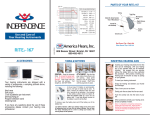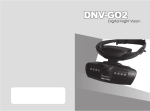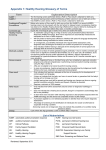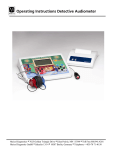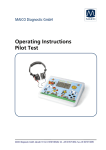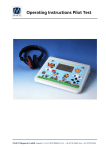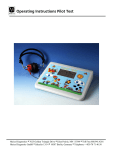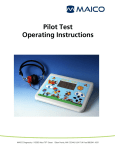Download Hearing Instrument User Manual
Transcript
Hearing Instrument User Manual Since 1979 QUALIT Y CONVENIENCE VALUE Table of Contents Battery Insertion 1 2 3 4 5 6 7 Inserting Hearing Aids 8 Volume Adjustment/Instruments On and Off 9 FreedomAD Models FreedomAD CIC FreedomAD MC FreedomAD CA FreedomAD HS FreedomAD FS Venting 10 Cleaning Hearing Aid 11 Wax Protection 12 Telephone Use 14 Memory Selection 15 Adaptive Directional Microphone Option 17 Wax and Moisture 18 Storing Hearing Aids and Use of Drying Kit 19 Special Precautions 20 Common Problems and Solutions 21 What To Expect 22 Additional Information 24 Virtual Office Software Get Connected 26 27 28 31 Contact America Hears 34 Uninstall Outdated Software Install New Software FreedomAD Models Thank you for choosing America Hears FreedomAD hearing aids! FreedomAD hearing aids are available exclusively from America Hears and offer you the latest in digital hearing aid technology and unparalleled convenience. With America Hears FreedomAD hearing aids you will enjoy the world's first wide dynamic range optimizer. Featuring ADRO® technology our instruments, with the power of DSP, carry out sophisticated analysis and implement fuzzy logic rules to continuously optimize output. This will provide you listening comfort as well as improved speech perception in all listening environments. Operating in 32 channels, your FreedomAD hearing aids provide natural amplified sound by using statistical analysis to compare and adjust the output of each channel of the hearing aid to comfortable and audible levels chosen by the user. There are no compression thresholds, ratios, or attack and release times to adjust, and gain levels change only when appropriate. Your hearing aids are programmed at the factory to your specific hearing loss. You also have the option of adjusting your hearing aids anytime you like, quickly and simply from your home or office with our optional remote programming package. Please carefully read the enclosed instructions to begin enjoying your new hearing aids. Should you have any questions please feel free to contact us and we will be happy to assist you. America Hears hearing professionals stand ready to provide you with any and all assistance you may need. Thank you again for your confidence in America Hears and our exclusive FreedomAD hearing aids. At America Hears, service to our customers is the hallmark upon which we have built our company – and we look forward to working with you for many years to come. We're always here to help: 800-492-4515 ADRO® is a registered Trade mark of Dynamic Hearing Pty. Ltd. FreedomAD CIC The FreedomAD CIC model is completely contained within the ear canal and provides the ultimate in cosmetic appeal. It utilizes a small size 10 battery and provides for the most natural telephone use of all the custom models. Parts of your hearing instrument: Since custom hearing aids are specially molded to fit your individual ear, no two custom hearing aids will look alike. Pictures in this manual are a general representation of what your hearing aid will look like. FreedomAD MC The FreedomAD MC model is larger than the CIC model but less visible than the CA model. It is easier to manage than the CIC model, while more discrete than the CA model. It utilizes a small size 10 battery. Parts of your hearing instrument: Since custom hearing aids are specially molded to fit your individual ear, no two custom hearing aids will look alike. Pictures in this manual are a general representation of what your hearing aid will look like. FreedomAD CA The FreedomAD CA model combines the advantages of natural ear acoustics with desired cosmetic appeal. It utilizes a size 312 battery for extended battery life. Parts of your hearing instrument: Since custom hearing aids are specially molded to fit your individual ear, no two custom hearing aids will look alike. Pictures in this manual are a general representation of what your hearing aid will look like. FreedomAD HS The FreedomAD HS model is slightly larger than the CA model, fitting into the lower portion of the concha (bowl area) in the visible part of the ear. Utilizing a size 312 battery, it has a more discrete appearance than the FS model and comes standard with an Adaptive Directional Microphone. Parts of your hearing instrument: Since custom hearing aids are specially molded to fit your individual ear, no two custom hearing aids will look alike. Pictures in this manual are a general representation of what your hearing aid will look like. FreedomAD FS The FreedomAD FS model is the largest model that fits completely within the ear. A good choice for individuals with limited dexterity and those with more severe hearing losses. It utilizes a size 312 battery for extended battery life. Parts of your hearing instrument: Since custom hearing aids are specially molded to fit your individual ear, no two custom hearing aids will look alike. Pictures in this manual are a general representation of what your hearing aid will look like. Battery Insertion Your hearing aids are designed to use a size 10 or a 312 battery. A zinc-air type battery is recommended, but any type or brand may be used. • To insert, remove the adhesive label and wait thirty seconds for air to activate the battery. Any moisture on the battery surface should be wiped off prior to insertion. Insert the battery into the battery door. It may take several minutes for the battery to work to its full effect. • To remove the battery, open the battery door and lift the battery out of the battery door. The Memory Selector Wand can also be used as a battery insertion and removal tool. To use for this application simply touch the battery with the tip of the Memory Selector Wand and insert or remove the battery as shown. Low battery indicator: When your battery voltage is low and in need of replacement you will hear the low battery indicator. You will hear five beeps indicating that it is time to change your battery. The warning beeps will be repeated. Helpful hint: It is recommended that you leave your battery door open when not using your instruments. This will prolong the life of your batteries. Battery disposal: Please discard batteries in a safe place. Never dispose of batteries by burning them. There is risk that they may explode, potentially causing serious injury. Never put batteries with household waste, as they cause environmental pollution. Radio Shack accepts dead hearing aid batteries. Other precautions: Keep batteries out of reach of children or anyone who may accidentally swallow them. Never put batteries in your mouth for any reason. Do not store batteries in medication containers or where they may possibly be mistaken for medication and accidentally swallowed. Never attempt to recharge non-rechargeable batteries. Inserting Hearing Aids Inserting your hearing instruments for the first time can be challenging. Until your hearing aid is fully inserted there can be feedback (whistle). We suggest that you practice without the battery until you have perfected this procedure. With practice inserting your hearing aids will become as easy as putting on your glasses. To insert your FS hearing aids: • Hold the instrument between your thumb and forefinger with the battery door facing away from your ear. • Gently insert the canal portion of the aid into your ear, rotating it slightly, to ensure proper placement. • Be sure that the instrument is seated in the ear properly and comfortably. To insert your HS, CA or MC aids: • Hold the instrument between your thumb and forefinger with the serial number facing forward as shown. • Gently insert into the ear, rotating slightly to ensure proper placement. To insert your CIC aids: • Close the battery door so that the hearing instrument is functioning. • Grasp the removal line with your thumb and forefinger with the serial number facing the front portion of the ear canal. • Gently insert the instrument into your ear canal (Never force the instrument beyond a comfortable point.) Note: To remove your CIC aids, grasp the knob on the end of the nylon removal line and pull the instrument gently from the ear canal. Note: It is important not to use the battery door as a handle to insert or remove your instruments. Volume Adjustment/Instruments On and Off All FreedomAD hearing aids have an internal automatic (self-adjusting) volume control. Select models can be ordered with an optional user adjustable volume control which allows you to adjust the range of the automatic volume control. The user adjustable volume control serves as both an on/off switch and a volume control. To adjust touch the tip of your finger to the volume control and rotate as follows: Right ear: With the hearing aids inserted, rotate the volume control clockwise to turn the instrument on and to increase the volume. Rotate counter-clockwise to reduce the volume and to turn the hearing instrument off. Left ear: With the hearing aids inserted, rotate the volume control counter-clockwise to turn the instrument on and to increase the volume. Rotate clockwise to reduce the volume and to turn the hearing instrument off. A custom hearing instrument with automatic (self-adjusting) volume controls will have no visible volume control. Turn the instrument off by partially opening the battery compartment and on by closing the battery compartment. Venting Venting: Most hearing aids come with a vent installed. Venting is useful for pressure relief and providing ventilation to the ear canal to help prevent moisture buildup. Proper venting will also make your own voice sound more natural to you. Vent size is limited by individual ear size and power requirements. As a general rule the largest vent size that will fit into your hearing aid that will allow you to function without feed back (squeal) is the best size for you. Select-a-Vent (SAV): Variable venting system that allows you to change the size of your vent. If your hearing aids are vented to accept SAV's then a supply of SAV plugs is provided in your hearing aid pouch. To change an SAV plug first remove the existing plug. Insert the new SAV plug into the hearing aid before removing it from the SAV tree. Push the SAV firmly until it is completely inserted. SAV plugs are tapered to make a tight fit when it is completely inserted. When it is completely inserted then break the plug free from the tree. Cleaning Hearing Aid It is very important to keep your hearing instruments as clean as possible. Wax buildup is the number one cause of instrument failure. To avoid potential repairs, please clean your instrument daily. Wipe your instruments clean with a soft, dry cloth, carefully removing any traces of wax and debris. A brush and vent cleaning tool is provided to further assist you in cleaning the sound port of your instruments. The vent cleaning tool helps remove wax and debris from the vent. Insert as shown. Wax Protection Wax Protection systems are used to accumulate wax and debris before it reaches your hearing aid components. This makes wax accumulation easier to clean and can prevent damage to your internal components of your hearing instruments. America Hears hearing instruments feature our WaxStop system: WaxStop and WaxStop tool Tip of WaxStop tool Positive tip Negative tip Sound port of hearing aid The WaxStop tool has a positive and a negative tip. The negative tip has a raised dot above it. The WaxStop is inserted into the sound port of your hearing aid. To insert: • Place a WaxStop on the negative tip of the WaxStop tool. • Insert the WaxStop into the sound port of your hearing aid. • Remove the WaxStop tool, leaving the WaxStop securely in place. To remove: • Place the positive tip of the WaxStop tool into the WaxStop in your hearing aid. • Remove the WaxStop tool, pulling the WaxStop out of the sound port. The WaxStop can be cleaned by soaking them in hot water for 10 minutes with a mild detergent. Once dried thoroughly they can be reused. Telephone Use There are three options to optimize your hearing aids when using the telephone. Option 1: The most convenient way to use the telephone is to simply put the phone to you ear without changing memories and use the phone in the conventional manner. Try this first. It is important that you hold the phone still and in one place as you talk. Depending on the style of your hearing aid and severity of your hearing loss you could experience feedback (squealing) when using the phone. If you do experience feedback then adjust the position of the phone as shown. Option 2: Before putting the phone to your ear adjust your hearing aid to the memory for the telephone situation (typically Memory 3). The telephone situation is adjusted for optimum telephone usage. Option 3: If your hearing aid is equipped with the telecoil option then adjust your hearing aid to the memory with the active telecoil (typically Memory 3.) This will activate the telecoil and adjust the hearing aid for optimum phone use with the telecoil. When the telecoil is active the microphone is inactive eliminating any chance of feedback (squeal.) The telephone is inductively coupled directly to your hearing aid enabling clear feedback free telephone usage. Note: Instruments with the telecoil option can pick up a buzzing sound from fluorescent lights Not all telephones are compatible with a telecoil. Check with the manufacturer of your telephone if you have any questions. It is a good idea to practice using the telephone a few times before you receive an actual call. Memory Selection Your FreedomAD hearing instruments are equipped with a multi-memory option that has four independently programmable memories (response settings.) Memories one, two and three are computer programmed to your specific hearing requirements and are factory adjusted for the three listening environments you encounter most often. The fourth memory is left inactive until you are ready to customize it to a setting of your choice. Your hearing aids are programmed as follows: • Memory 1: General use - normal to quiet environments like home, small meetings, and communicating with friends and family. • Memory 2: Noisy situations like restaurants, shopping malls, and crowded places. • Memory 3: Telephone use without feedback (whistling). • Memory 4: Inactive until programmed using Virtual Office Clients who require settings for specific listening situations can customize their memory settings by utilizing our exclusive Virtual Office software that allows for online or do-it-yourself programming. America Hears would be glad to do this adjustment for you. Just contact a customer service representative for details. When the hearing aid is first turned on, it automatically defaults to Memory 1. You can change between memories using the Memory Selector Wand or push button. You will hear a series of beeps which will represent which memory you are changing to: • Memory 1: One Beep • Memory 2: Two Beeps • Memory 3: Three Beeps • Memory 4: Four Beeps • To use the memory selector wand touch the front of your ear with the tip of the wand. To change to the next memory move the wand away from your ear and then return it back to the front of your ear. • To use the push button place your finger over the push button and press gently. Continue pressing and releasing the push button until you have selected the memory you want. Warning: Please do not place the Memory Selector Wand on or near computer equipment, software, discs or credit cards. Information could be lost/destroyed as a result. Adaptive Directional Microphone Option Instruments equipped with the directional microphone option have two microphone modes: directional and omni. America Hear's Adaptive Directional Microphone (ADM) Module is a superior directional microphone system. With sophisticated monitoring of multiple microphones, the module is able to adapt in and out of an omni directional mode, all the while optimising the polar pattern for the listener. Extremely power efficient, the ADM has a flat frequency response, meaning that the same fitting can be as for an omni directional fitting. Wax and Moisture Ears normally produce wax and moisture which can damage your instrument. Proper cleaning and storage of your instruments will help prolong periods between professional cleaning and repairs but eventually your instruments will need to be professionally serviced to compensate for wax and moisture contamination. Some individuals are prone to wax and moisture problems and need to have their instrument serviced on a regular basis. Wax and moisture collect in the narrow openings of the hearing instrument microphone ports and sound openings eventually clogging them. The hearing instrument will appear to be dead or will have a hiss sound. This problem can be intermittent; when the moisture dries the instrument will function normally, but as it builds up the instrument will again appear dead or hiss. Storing Hearing Aids and Use of Drying Kit A special drying kit is included with your hearing instruments. The jar contains beads that are specially designed to remove moisture from your hearing instruments. We recommend that you store your hearing instruments in the drying kit overnight while you are sleeping. Doing so can help extend the life of your hearing instruments. To use: Open the battery door of your hearing instruments, place them on top of the circular foam piece, and firmly secure lid on the jar. Removing the batteries completely will extend battery life. Keeping the lid firmly in place at all times will extend the time between reactivation. There is a small amount of blue beads in the jar that are designed to fade and blend in with the other beads when it is time to reactivate. After reactivation these beads will return to their original blue color. To reactivate in a microwave oven: Pour beads into a microwave safe container. Heat on a medium level for about 2.5 minutes or until the blue beads regain their color. To reactivate in a conventional oven: Pour beads into an oven safe container and bake at 350 degrees for about 30 minutes or until the blue beads regain their color. Allow the beads to cool to room temperature before placing them back into the jar. PLEASE NEVER PUT YOUR HEARING INSTRUMENTS, BATTERIES, GLASS JAR, LID OR FOAM IN OVEN OR MICROWAVE. DO NOT PLACE OVER AN OPEN FLAME. WARNING: Beads are non-toxic but should not be ingested. Keep out of reach of children and pets. If ingested, drink 2 glasses of water, induce vomiting and contact your local poison control center. Special Precautions Your instruments are delicate, precision electronic devices and as such, require the special care and handling that would be afforded to any fine piece of equipment. Please read and follow the listed precautions to insure quality performance and long instrument life: • Remove your batteries when your hearing instruments will not be in use for prolonged periods of time. • Store your instruments in the drying kit provided when not in use. • Do not throw or drop your instruments. • Do not immerse hearing instruments in liquid or water. • Do not wear during bathing, showering, or swimming. • Do not expose instruments to excessive heat, such as a stove top, microwave, dash board of a hot car, or a hair dryer. • Do not expose the instruments to chemicals, such as hair spray, insect repellent, perfume, or cosmetics. Special Note: Your hearing instruments are built with the finest quality materials. However, in rare instances, an individual may experience sensitivity to the materials used. Please consult with your physician if you exhibit any signs of skin irritation, allergic reaction, or accelerated accumulation of cerumen (wax). Should you have a sensitivity problem, please call or send us an email to inquire about special hypoallergenic coatings available to assist with these situations. Common Problems and Solutions If you experience any problems with your instruments that you are unable to resolve, contact America Hears for assistance. Please do not attempt to make repairs yourself. Doing so could cause additional damage and will void any warranties still in effect. All repairs must be handled through America Hears. What To Expect Welcome To The America Hears Family Congratulations on the purchase of America Hears hearing instruments. You've taken the first step toward improving your hearing, and improving your lifestyle. Please know that we are only an email or toll-free phone call away to answer any questions you may have. Common Hearing Loss Hearing aids are particularly useful for improving the hearing and speech comprehension of those with sensorineural hearing loss. This is a loss of hearing that takes place when there is damage to the inner ear, also known as the cochlea, or damage to the nerve pathways from the inner ear to the brain (the retocochlear). This type of hearing loss can be attributed to any number of factors, including viruses or disease, drugs or medications that affect the auditory system, noise exposure, head trauma, aging or tumors. Using Your New Hearing Aids America Hears 100% digital hearing aids are sophisticated hearing instruments. Our software and technologies are state-of-the-art. Nevertheless there are human factors involved in using any brand of hearing aids, most notably Time & Patience. No hearing aid can completely restore perfect/normal hearing. While we use cutting edge technology to eliminate noise, noise cannot be completely eliminated in all hearing environments. In using your new hearing aids you will learn how to listen in a variety of noise and noise-free environments. You will gradually learn to effectively process all of the sounds around you – including sounds you may not have heard for years. If you are a first time hearing aid user, we suggest using your instruments under nonstressful circumstances for a few hours at a time. Getting used to wearing your new hearing aid, gradually and at a comfortable pace will make the transition period much easier and more rewarding for you. We Help You Avoid The Occlusion-Effect If you are new to wearing hearing aids you may experience a sensation known as "the occlusion-effect". This is a feeling that your hearing aid is actually blocking certain sounds. This is very common. America Hears has taken steps to combat this sensation in our new FreedomAD models by building in a vent which allows air to flow in and out of your ear, as if you were not using a hearing aid at all. Your vent can be adjusted to allow for more or less air. If you experience the occlusion-effect, please follow instructions for adjusting the vent. Our self-programming features will also help eliminate this effect. If you have any difficulty please contact us via email or using our toll-free number for assistance. Hearing Your Own Voice Hearing aids can open up new avenues of hearing for you. One sound that at first may take some getting used to will be the sound of your own voice. If your hearing loss occurred over a period of time, your brain gradually adjusted to recognizing your own voice through bone conduction only rather than a combination of bone conduction and air conduction. Bone conduction is the process of your body using the vibrations felt by your jaw and skull to process sound rather through your outer and middle ear. You will gradually get used to the 'new' sound of both your own voice and other voices. However, if you still find the sound distracting after a week or so, please call our hearing aid professionals, or e-mail us so we can best assist you. Usually, adjustments in the programming of your hearing aids will help. We Are Always Here To Help Please remember time and patience in wearing any new hearing aid will usually result in an improvement in your hearing. Your new America Hears hearing aids, while technologically superior to most other hearing aids, could also require time and patience. Hearing aids work with the hearing you do have to improve it – a return to "perfect" or "normal" hearing is rare with any hearing aid. While you are getting accustomed your new America Hears hearing aids, follow the instructions and consult with your America Hears professional. You will soon experience a new level of hearing. Always remember, our pledge to customer service Before, During and After the sale insures we will be with you every step of the way. We look forward to serving your hearing needs for many years to come. Additional Information If you have difficulty hearing, you are not alone. Millions of people in this country share your problem. Many people who experience hearing problems can be treated medically, surgically, or most commonly, through amplification. Your hearing is vital for your physical and psychological well being. Without it, everyday communication may become a frustrating and sometimes exhausting task. Hearing instruments will not restore your hearing to normal; however, when fitted properly and used regularly, they will improve your communication ability. Your hearing instruments may only be a part of your hearing rehabilitation. You may also need auditory training and instruction in lip reading. For further information, contact America Hears. Hearing loss falls into two basic categories - conductive and sensorineural. When the structures in the outer and middle ear do not work properly, their ability to "conduct" sound vibrations to the inner ear is affected. Ear canal obstructions, such as wax occlusion, eardrum abnormalities, or conditions where the ossicles, tiny bones of the middle ear, become immobilized, are causes of conductive hearing loss. Sensorineural hearing loss or "nerve deafness" is when the inner ear does not properly process sound vibrations, thereby disrupting the message being passed on to the brain. Excessive noise exposure, ototoxic medications, aging, or genetics are known to be some of the reasons leading to or causing sensorineural hearing loss and typically cause a frustrating inability to hear speech clearly. Good health practice requires that persons with hearing loss have a medical evaluation by a licensed physician, preferably one who specializes in diseases of the ear, before purchasing hearing instruments. The purpose of this medical evaluation is to assure that all medically treatable conditions are identified and properly cared for prior to the purchase of a hearing instrument. Following this medical evaluation, your physician will provide you with a written statement that your hearing loss has been medically evaluated and that you may be considered a candidate for hearing instruments. Federal law restricts the sale of hearing instruments to those individuals who have obtained a medical evaluation from a licensed physician. Federal law permits a fully informed adult to sign a waiver statement declining the medical evaluation for religious or personal beliefs that preclude consultation with a physician. The exercise of this waiver is not in your best health interest and is strongly discouraged. Once a medical evaluation is completed, your physician will refer you to a hearing care professional for a full hearing evaluation. This evaluation will assess your ability to hear with and without hearing instruments. (This assessment will enable America Hears to select and fit hearing instruments designed to meet your specific hearing needs.) Children with hearing loss, in addition to seeing a physician for a medical evaluation, should be directed to an audiologist for evaluation and habilitation since hearing loss may cause problems for the child in language development and educational and social growth. An audiologist is qualified, by training, to assist in the evaluation and habilitation of a child with a hearing loss. Before you are fit with your hearing instruments, your hearing care professional should advise you to promptly seek medical attention if you are experiencing any of the following: 1. Visible congenital or traumatic deformity of the ear. 2. History of active drainage from the ear within the last 90 days. 3. History of sudden or rapidly progressive hearing loss within the previous 90 days. 4. Acute or chronic dizziness. 5. Unilateral hearing loss of sudden or recent onset within the previous 90 days. 6. Audiometric air-bone gap equal to or greater than 15 decibels at 500Hz, 1000Hz, or 2000Hz. 7. Visible evidence of significant cerumen (ear wax) accumulation or a foreign body in the ear canal. 8. Pain or discomfort in the ear. Note: The hearing care professional should exercise special care in selecting and fitting hearing instruments where maximum sound pressure level exceeds 132 decibels because there is a risk of impairing the remaining hearing of the instrument user. Virtual Office Software If you have purchased the optional programming kit you will receive a programming kit that enables you to adjust your own instruments or make remote adjustments via the internet. If you have not, you may do so by contacting our Customer Service Group. Welcome to the America Hears Virtual Office The purpose of The America Hears Virtual Office is to give you the ability to have greater control, and freedom, over your hearing – specifically adjusting your new digital hearing aids. All modern high-end digital hearing aids need to be adjusted and fine-tuned to the user's individual and unique hearing loss. Adjustments are also needed to take into account the users lifestyle and personal preferences. The adjustment process is dependent on the skills of the local hearing care provider and often requires multiple appointments and visits to the hearing professional's office. This is often inconvenient and many people never reach the level of satisfaction they are seeking. America Hears exclusive Virtual Office Software can change that. You will have control over your hearing and the freedom to make adjustments at your convenience. Minimum computer requirements: • Processor : Pentium III or higher • RAM : 128 Mb minimum, 256 recommended • 100 MB free hard disk space • One USB port • Windows 98, Windows 2000, Windows XP – recommended • Screen resolution setting 1280x1024 pixels Uninstall Outdated Software If you have previously installed a version of America Hears software you must first uninstall before installing a new version. • To uninstall click the Start button on your desktop. • Highlight to select Programs. • Highlight to select America Hears Virtual Office or America Hears for previous versions • Highlight to select Uninstall. A message box will pop up asking you if you are sure you want to uninstall the software. • Click the Yes button. Once the software uninstall process is complete you must reboot your computer by using the shutdown/restart process. Install New Software It is important that you do not connect the America Hears programmer to your computer until after you have installed the software. • Place the America Hears Virtual Office installation CD into your CD drive and follow the on screen instructions. This process may take a few minutes to complete. Follow the on screen directions as follows: • Click the Next button. • Click the Next button. • Click the Next button. • Click the Finish button. • Click the Install button. Note: This process could take a few minutes to complete. • Click the OK button to complete the installation process. • Plug the USB cord into your computer. • Plug the programmer into the USB port of your computer. A windows message will pop up in the lower right corner of your screen. The drivers are automatically installed for you. When the messages disappear, the process is complete. The green power light on the programmer will be on, confirming that the installation process is successful. • Launch America Hears Virtual Office by double clicking on the Virtual Office icon on your desktop. The detailed Help program in Virtual Office will step you through the software. Get Connected If you have purchased the optional programming kit you will receive a programming kit that enables you to adjust your own instruments or make remote adjustments via the internet. If you have not, you may do so by contacting our Customer Service Group. Note: Before launching America Hears software you have to connect your hearing instruments to your programmer and the programmer to your computer. If you need any assistance in this process please do not hesitate to call one of our customer service representatives. Programming Cable Programming Cable Plug FreedomAD MC, CA, HS, and FS hearing aids are designed to attach easily to your programming cords via the programming socket. • There is a color dot on the rim of the socket. A similar dot is located on the cable end plug. Align these dots. • Carefully insert the cable plug into the programming socket. Insert the red plug into the right hearing aid and the blue plug into the left hearing aid. Do not try to force this connection. • Rotate the plug with respect to the receptacle while applying slight pressure. • When the alignment is felt, then apply slightly more pressure to assure the connection is complete. Note: These sockets are very small and you must take care in attaching the cables to them. FreedomAD CIC hearing aids use a ribbon connector to connect the programming cord to the hearing instruments. Please note: Flex connectors are extremely fragile. When handled properly they can last the life of your instrument. Flex connectors have a limited warranty of 60 days from date of invoice. If you need additional flex connectors they may be purchased as an accessory. Please call America Hears customer service representative for more information. • Align the red dots on the ribbon connector and the programming cable. • Connect the programming cable to the ribbon connector. • Open the battery door slightly to create a space on the hinged side of the battery door. • Insert ribbon connector into the space created on the hinged side of the battery door of the hearing instrument. Insert the red plug/ribbon connector into the right hearing aid and the blue plug/ribbon connector into the left hearing aid. Do not try to force this connection. Note: The gold shiny side of the ribbon must be facing away from the battery compartment. • Close the battery door. Attach programming cords to programmer: • Attach your America Hears programmer to the programming cords matching the blue and red colors on the cords to the programmer. • Connect to your computer using the USB cable. • Launch America Hears Virtual Office by double clicking on the Virtual Office icon on your desktop. Contact America Hears To contact America Hears: Call: 1-800-492-4515 E-mail: [email protected]







































